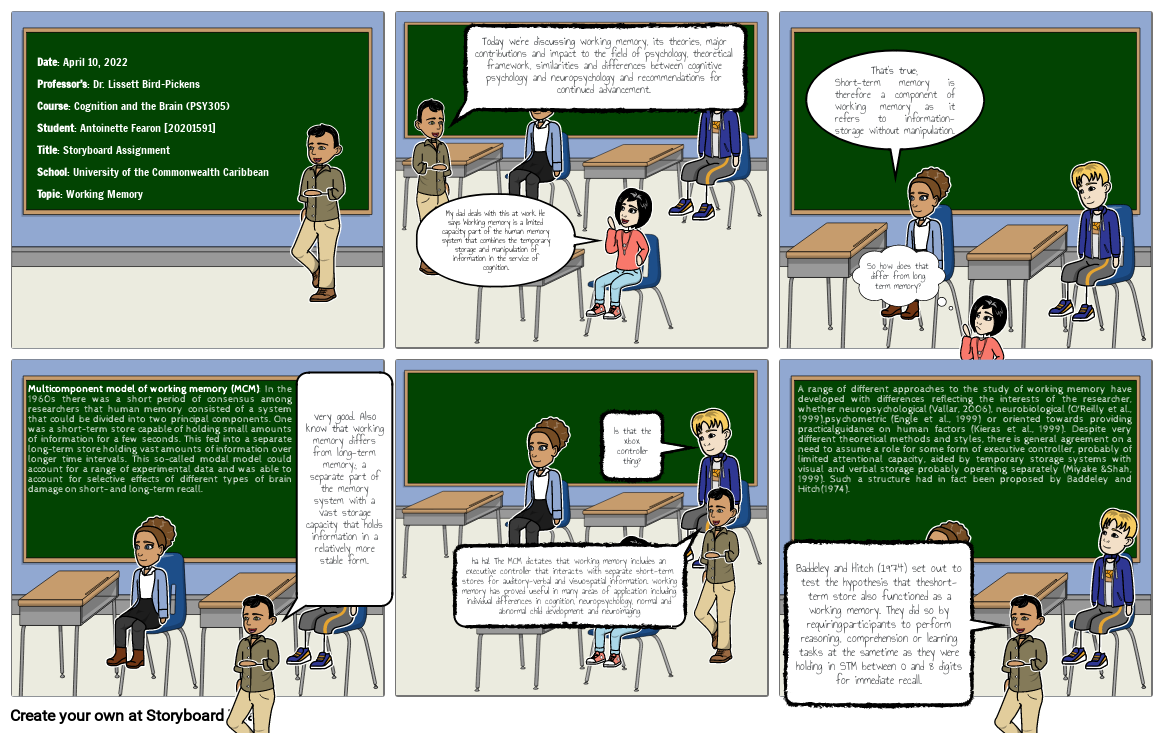A. Fearon Cognitive Storyboard

Storyboard Text
- Date: April 10, 2022Professor’s: Dr. Lissett Bird-PickensCourse: Cognition and the Brain (PSY305)Student: Antoinette Fearon [20201591]Title: Storyboard AssignmentSchool: University of the Commonwealth Caribbean Topic: Working Memory
- Today we're discussing working memory, its theories, major contributions and impact to the field of psychology, theoretical framework, similarities and differences between cognitive psychology and neuropsychology and recommendations for continued advancement.
- My dad deals with this at work. He says Working memory is a limited capacity part of the human memory system that combines the temporary storage and manipulation of information in the service of cognition.
- That's true; Short-term memory is therefore a component of working memory as it refers to information-storage without manipulation.
- So how does that differ from long term memory?
- Multicomponent model of working memory (MCM): In the 1960s there was a short period of consensus among researchers that human memory consisted of a system that could be divided into two principal components. One was a short-term store capable of holding small amounts of information for a few seconds. This fed into a separate long-term store holding vast amounts of information over longer time intervals. This so-called modal model could account for a range of experimental data and was able to account for selective effects of different types of brain damage on short- and long-term recall.
- very good. Also know that working memory differs from long-term memory,; a separate part of the memory system with a vast storage capacity that holds information in a relatively more stable form.
- ha ha! The MCM dictates that working memory includes an executive controller that interacts with separate short-term stores for auditory-verbal and visuospatial information. working memory has proved useful in many areas of application including individual differences in cognition, neuropsychology, normal and abnormal child development and neuroimaging
- Is that the xbox controller thing?
- A range of different approaches to the study of working memory have developed with differences reflecting the interests of the researcher, whether neuropsychological (Vallar, 2006), neurobiological (O'Reilly et al., 1999),psychometric (Engle et al., 1999) or oriented towards providing practicalguidance on human factors (Kieras et al., 1999). Despite very different theoretical methods and styles, there is general agreement on a need to assume a role for some form of executive controller, probably of limited attentional capacity, aided by temporary storage systems with visual and verbal storage probably operating separately (Miyake &Shah, 1999). Such a structure had in fact been proposed by Baddeley and Hitch(1974).
- Baddeley and Hitch (1974) set out to test the hypothesis that theshort-term store also functioned as a working memory. They did so by requiringparticipants to perform reasoning, comprehension or learning tasks at the sametime as they were holding in STM between 0 and 8 digits for immediate recall.
Over 30 Million Storyboards Created

